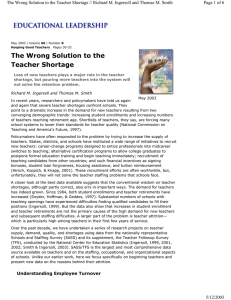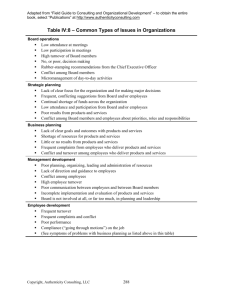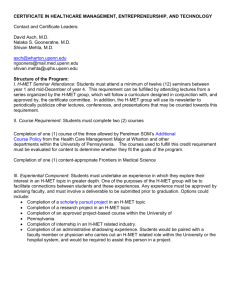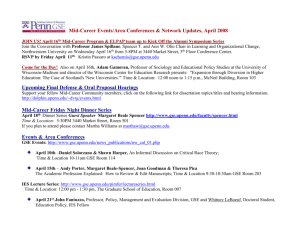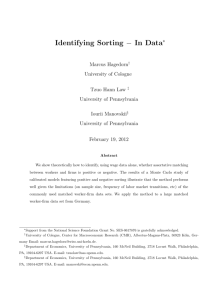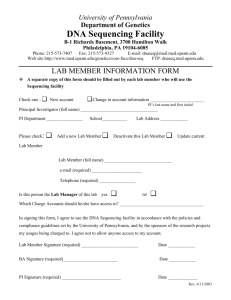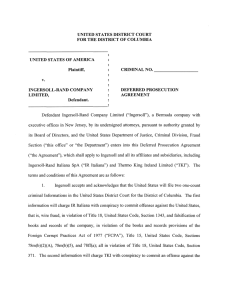Is There Really a Shortage of Mathematics, Science and Special
advertisement
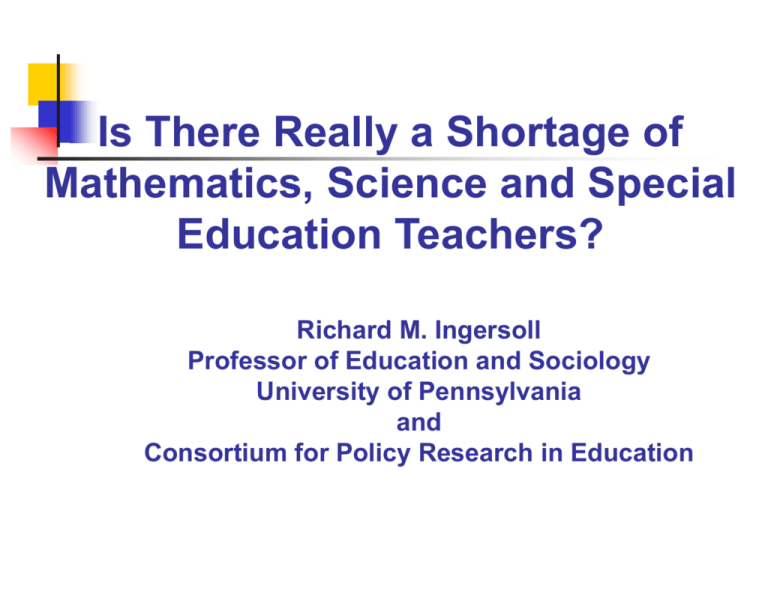
Is There Really a Shortage of Mathematics, Science and Special Education Teachers? Richard M. Ingersoll Professor of Education and Sociology University of Pennsylvania and Consortium for Policy Research in Education The Source of Data The Schools and Staffing Survey with the Teacher Follow-up Survey Conducted by the Census Bureau for the U.S. Department of Education 5 Cycles: 1987-1989, 1990-1992 1993-1995, 1999-2001 2003-2004 - forthcoming The largest source of information available on teachers: -Sample: 55,000 teachers 12,000 schools -Representing all 50 states Percent Secondary Schools with Difficulties Filling their Teaching Vacancies, by Field. 42 Mathematics 34 Special Educ Life Science 30 Foreign Lang 29 27 Physical Science 24 English 21 Music/Art 14 Social Studies 0 20 40 60 80 100 Percent Source: Ingersoll, R. 2003. Is There Really a Teacher Shortage? Consortium for Policy Research in Education, University of Pennsylvania, http://www.gse.upenn.edu/faculty_research/Shortage-RMI-09-2003.pdf Percent Annual Teacher Turnover, by Field All Teachers 14.3 Math 16.4 Science 15.6 14.5 Special Educ. - Elementary Elementary Movers Leavers 14 Special Educ. - Secondary 13.5 Voc. Tech. 13.4 12.4 English Social Studies 9.4 0 10 20 30 Percent 40 50 Numbers of US Teachers in Transition Before and After 1999-2000 School Year Entrants 534,861 Teaching Force 3,443,467 Departures 546,411 Source: Ingersoll, R. 2003. Is There Really a Teacher Shortage? Consortium for Policy Research in Education, University of Pennsylvania, http://www.gse.upenn.edu/faculty_research/Shortage-RMI-09-2003.pdf Beginning Teacher Attrition (Cumulative Percent Teachers Having Left Teaching Occupation, by Years of Experience) After 1 year 14 After 2 years 24 After 3 years 33 After 4 years 40 After 5 years 46 0 20 40 60 80 100 Percent Source: Ingersoll, R. 2003. Is There Really a Teacher Shortage? Consortium for Policy Research in Education, University of Pennsylvania, http://www.gse.upenn.edu/faculty_research/Shortage-RMI-09-2003.pdf Percent Annual Public School Teacher Turnover, by Selected School Characteristics 15 All Public Large/Suburban/Notpoor 11 Small/Suburban/NotPoor 16 Large/Urban/Poor 19 Small/Rural/Poor 22 26 Small/Urban/Poor 0 5 10 15 Percent 20 25 30 Percent Teachers Giving Various Reasons for Their Turnover, by Field 14 11 10 Retirement 8 School Staffing Action Other 6 5 Math/Science 40 Family or Personal 44 Spec. Educ. 19 39 To Pursue Other Job 30 36 50 50 Dissatisfaction 62 0 20 40 Percent 60 80 100 Of Those School Teachers Who Moved From or Left Their School, Percent Reporting Various Sources of Dissatisfaction, by Field Too little prep time 61 68 58 Too heavy teaching load 48 48 56 Poor salary or benefits 61 Other Math/Science Spec.Educ. 54 50 53 49 Class sizes too large 50 46 45 Student behavioral problems 49 Lack of faculty influence 57 50 0 20 40 60 Percent 80 100 Percent Turnover After First Year of Beginning Teachers, According to Amount of Induction Support They Received No Induction 41 Some Induction (4 Components) 27 Full Induction (7Components) 18 0 10 20 30 40 50 Percent Movers Leavers Smith, T. & Ingersoll, R. 2004 "What are the Effects of Induction and Mentoring on Beginning Teacher Turnover?" American Educational Research Journal. 41: 3: 681-714. http://www.gse.upenn.edu/faculty_research/Effects-of-Induction-and-Mentoring-RMI-Fall-2004.pdf Percent Percent Voluntary Turnover of Teachers, According to Amount of Faculty Influence over School Decisions and Policies Low Faculty Influence High Note: “Voluntary Turnover” excludes retirements, layoffs, terminations and involuntary transfers Source: Ingersoll, R. 2003. Who Controls Teachers’ Work? Cambridge, MA: Harvard University Press. http://www.hup.harvard.edu/catalog/INGWHO.html For Further Information, Copies of Articles, Reports, etc.: www.gse.upenn.edu/faculty/ingersoll.html and a recent book: Who Controls Teachers’ Work? Power and Accountability in America’s Schools. from Harvard University Press www.hup.harvard.edu/catalog/INGWHO.html

